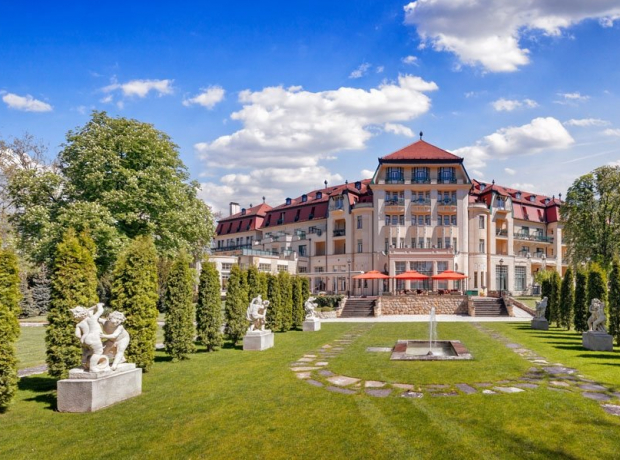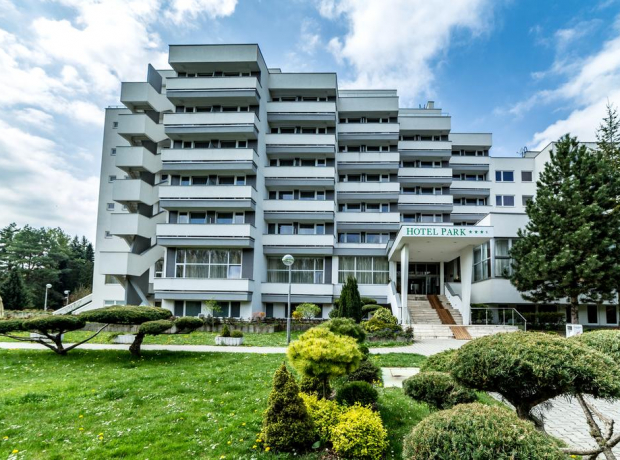Piešťany Spa - Danubius Health Spa Resort ESPLANADE****
For more than 100 years, the Slovak spa town of Piešťany has been one of the leading European baths in the treatment of rheumatism, rehabilitation of the musculoskeletal system and nervous system . They use natural resources - unique healing sulfur mud and thermal mineral water. Specialized healing techniques reduce the inflammation in the joints and restores their mobility. The immune system is strengthened, damaged cartilage is regenerated, and the degenerative joint process slows down. Specialists and experienced physicians compile a treatment program for each guest individually.
Spa Resort Danubius Health Spa Resort Esplanade is a four-star wellness hotel in Piešťany . This modern complex, built in 1980, has undergone extensive reconstruction in recent years. The non-smoking hotel in the heart of the Spa Island focuses on health care. It cooperates with the excellent Balnea Health Spa, which offers a wide choice of unique therapeutic and relaxation treatments. The hotel's wellness offer is really varied, ranging from spa and wellness stays to sporting activities, conferences, and excellent cuisine and entertainment. The attractive Water and Sauna World provides indoor and outdoor swimming pools with many different types of saunas. For those who like fitness, jogging, golfing, tennis, squash, cycling, petanging, table tennis, bowling, water sports or fishing in a glamorous, green environment.
In 1980 the spa hotel Balnea Esplanade was built. Gradually, the hotel is renovated. In 2004 the Water and Sauna World was renovated, making it a great attraction for guests. At present, Balnea Esplanade Palace complex, thanks to its comfort and facilities, is not only sought after by spa guests, but also by active people and families with children. Various international conferences were held in the hotel complex.
Rooms
Hotel Balnea Esplanade offers accommodation in 260 rooms, including 15 suites and 129 Premium rooms and in the Palace Palace 198 rooms including 6 suites. Guests of the Esplanade Hotel can choose from different types of rooms, ranging from Standard or Comfort to premium Premium and Premium plus. Apartments within Comfort, Superior and Premium classes offer visitors balconies overlooking the tranquil setting of Piešťany's Spa Island.
Danubius Health Spa Resort ESPLANADE****
Zadaným podmienkam nevyhovujú žiadne produkty
Spa history
Piešťany is interesting for foreigners simply because of its name. Etymologists see the origin of the name Pescan in the word "sand". The first settlements originated near the sandy soils around the River Váh. Archaeologists have found here and in surrounding locations incredibly interesting discoveries, such as bones of prehistoric animals and traces of some settlements by prehistoric humans that give evidence of the attraction of the hot springs in this fertile valley. An exceptionally precious and rare find from this region is the delicate statue of a woman carved from a mammoth’s tusk, well-known as Moravany Venus. Scientists estimate her age at about 22,860 years old.
People say that the curative effects of our springs were first discovered by Roman legions. Roman horses were so tired after their long journey that they could not continue without rest. Soldiers then decided to relax for several days next to a muddy meadow near the River Váh. They supposedly continued their journey after this stay unusually refreshed.
The first written reference about Piešťany is stated in a deed from Zoborská in 1113. The future fame and international reputation of Piešťany as a spa town began to be born in the second half of the 17th century. In the 15th – 17th centuries, a professional interest in curative healing baths and mineral waters grew in Central Europe.
In 1642, the Czech scholar and intellectual Adam Trajan Benešovský from Benešov, in the ode Saluberrimae Pistinienses Thermae, glorified and celebrated with his poetry the curative healing effects of Spa Piešťany. He lyrically described the raging river with a raft, float, nobleman's residence, noblemen and aristocrats and peasants, a fertile valley and crowds of people who came to dive into hot baths and mud holes in the spring, when nature returned to life.
Aristocrats and noblemen, owners of grounds and properties, started to build the current spa buildings above the springs. So the first spas in Piešťany were created as well. In 1821, the squire of Piešťany Count Jozef Erdödy, head of the Nitriansky region and state minister of the Vienna government, began construction of the first bathtub and pool baths. He began constructing the first bathhouse - Napoleon´s Spas and the first mirror pool, in Piešťany after the Napoleonic wars ended, with the aim of healing and treating wounded soldiers (1822).
The beginnings of progressive rational changes in Piešťany´s curative healing methods meant the arrival of Dr. František E. Scherer, M.D., pioneer of modern balneal therapy, who worked in Piešťany Spa from 1829 to 1837. He advocated an individual approach for the prescription of curative cures based on advance defined diagnosis, and on the phase of the advanced state of disease of the patient.
A crucial era in the development of the spas of Piešťany is wedded to the name of the family Winter. At the beginning of the 20th century, the spa hotel Thermia Palace was created along with the balneal therapy building Irma (1912), the spa hotel Pro Patria (1916) and the Hotel Excelsior in the thirties in the functional style (now Jalta). Father Alexander and later his sons, especially Ľudovít and Imrich, served and managed the development of cultural and social life in Piešťany, and for the first time they struggled and attempted to combine the common interests and needs of the town and the spa. They laid the foundations of the Balneology Museum, and invited young and talented doctors and physicians to Piešťany. Some of the more notable include: František Ernest Scherer, Adalbert Wagner, Hermann Alter, Samuel Weinberger, Koloman Fodor, Eduard Weisz, father and son Zigmund and Leo Alexandre, Vratislav Kučera, Eduard Cmunt, Ladislav Schmidt, Jozef Brežný, Gejza Vámoš, Štefan Kollár and others.
During the era and period of spas managed by the Winters, the roads and transportation system improved dramatically. Many new schools were built as well as a new post office, the pedestrian Colonnaded Bridge with its symbol of the Spa – a bronze statue of a man, Crutch Breaker, and the unique outdoor pool Eva. The first golf course in Slovakia was built on Spa Island. Piešťany became the centre of significant golf tournaments, tennis competitions and chess championships, but also concert exhibitions, dance competitions, car racing tournaments and the Concours d´ Elegance championship.
Medical & Spa Treatment
World-famous Spa Piešťany owes its reputation mainly to the remarkable natural springs, the unique healing potential of which has been verified by hundreds of generations, both in the distant as well as in recent past. The "crutch breaker", the famous symbol of Spa Piešťany, is a very accurate expression of the healing nature of Piešťany's natural phenomenon. The real idea behind the crutch breaker is not at all exaggerated, because a crutch is something which becomes redundant for many of our patients after treatment. This was the case in the past and is the same nowadays, and we will do our best to ensure that this remains true in the future as well.
Natural healing sources
The unique healing sources are the reason why people have come to Piešťany for centuries, and this is also the reason why the spas were created here.
The healing effects of the local thermal mineral water and sulphur mud were first described by physicians in the 14th century.
Thermal mineral sulphur water
Thermal mineral water in Spa Piešťany has a high content of minerals (1500 mg per litre). The water also contains hydrogen sulphide and other free gases. It springs from tectonics faults from a depth of about 2000 metres. The water temperature of the springs is 67 - 69°C. Its output is around 3 million litres daily.
Sulphur mud
Sulphur mud is a unique peloid both on a European as well as a world-wide scale. Its base is a homogenised sediment collected in the riverbed of the River Váh, on the site of the current hot springs with sulphuric thermal mineral water.
The mud has important antifungal features. It is prepared for balneology application using original technology, which causes it to mature and regenerate, accompanied by a multitude of chemical and biological reactions. The mature mud has a butter-like consistency, and is greasy, malleable, with good heat conducting features. It cools down four times slower than water, and has a viscosity 350 times higher than water. The mud application temperature is approximately 45°C, and the duration of a partial or total wrap is 20 minutes. The wrap causes a temporary local, as well as total overheating of the body, which depends on the application area of the wrap. The mud wrap causes the reduction of local swellings around joints, reduction of muscle tension, and better nutrient supply to cartilages, connective tissues and intervertebral discs. It strengthens anti-inflammatory activity and immune processes within the body, preventing the degradation of elastine, collagen and hyaluronane, thus improving the functions of cartilage, connective tissues and joint movement.
Therapeutic Indications
Rheumatic inflammatory disorders (rheumatic arthritis, Bechterew's disesase; soft tissue rheumatism, fibrositis, fibromyalgy), degenerative non-inflammatory rheumatic disorders (erosion, metabolic arthropathies – gouty arthritis, premature aging of the musculoskeletal system), neural disorders (sciatica, CB - syndrome, nerve paralysis, posture disorders of the skeletal system) orthopedic disorders (scoliosis, spine deformations, post-surgery and post-traumatic disorders of the musculoskeletal system).
Contraindications
Infectious diseases, cardio-respiratory system failure, acute thrombophlebitis, acute inflammatory rheumatic diseases, metastatic tumours, acute psychosis, labile diabetes with repetitive acidity, pregnancy, addiction to alcohol or other habitual drugs, incontinence, states requiring care by a third person, epilepsy with frequent seizures.
Therapeutic services and treatments:
-
Diagnostic section: doctor’s check up, laboratory tests, ECG
-
Balneotherapy: mud pool, thermal mineral bath (mirror pool), individual thermal mineral bath, individual thermal bubble bath, carbon dioxide thermal bath
-
Hydrotherapy: hydromassage, bubble bath, underwater jet massage, stepping bath, underwater traction
-
Physiotherapy: medical massage, individual and group therapeutic exercise, water rehabilitation, rehabilitation path, traction, segment and connective tissue massage, foot reflex massage, lymph massage, antispastic kinesiotherapy, manipulation and mobilisation therapy, ergo therapy
-
Electrotherapy: galvanic bath, four cell galvanic bath, interference, diadynamic stimulus current therapy, magnetic therapy, ultrasound therapy
-
Packs: mud pack (full-body or local), parafango pack, paraffin pack
-
Inhalation: inhalation, oxygen inhalation
-
Phototherapy: laser therapy, bioptron lamp
-
Acupuncture
-
Other: natural dry carbon gas bath, CO2 natural gas injections
-
Individualised nutrition advice
The consulting rooms of the spa physicians are situated directly in the hotel. We provide curative treatments in the balneo-rehabilitation centre, which is connected to the hotel by corridor.
Medical treatments are provided between 7:00 and 16:00. Relaxation treatments and treatments not requiring a doctor´s examination are available during all spa opening times. Treatments may be restricted on the following public holidays: 1 January, Easter, 25 December.
























































































































































































































